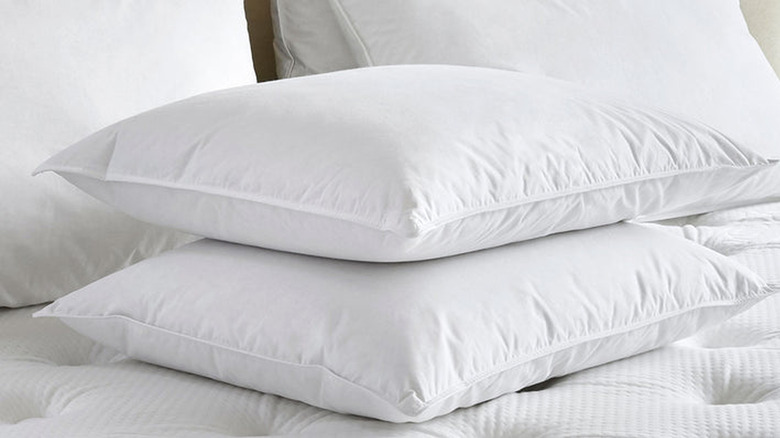Red Flags To Know About Pillows To Avoid Common Toxins
Is it time to replace your bedding? Shopping around for a good pillow is just as essential as finding the perfect mattress — and not just in terms of comfort, either. One of the biggest mistakes people make when buying pillows is not checking to see whether it's free of toxins.
There's a lot more hiding from you in your average pillow than you might think. Inorganic materials such as polyester and memory foam can release chemicals into the air over time, irritating your skin and lungs — not to mention the fact that they aren't biodegradable either, which is a serious problem when you think about how often you should be changing out your pillows. Even natural materials like cotton, when grown with fertilizers and pesticides, carry these chemicals from where they were planted all the way into your very own pillow. Thinking that duck or goose-down pillows are the best option? Bad news — these feathers are often chemically treated before they make their way into your pillow stuffing. Even down alternatives fall victim to their already vague name because they're often filled with a variety of potentially hazardous materials, too.
All of these pillow facts might be downright making you lose sleep. But don't lose hope just yet — instead, let's talk about the best way to shop for non-toxic pillows.
Organic and VOC-free pillows
First of all, before you start pillow shopping, you need to know about VOCs — and why they're even in your pillows in the first place. VOCs, or Volatile Organic Compounds, are toxic chemicals that evaporate into the air, meaning you can breathe them in. Both long-term and short-term exposure to VOCs can have harmful side effects, especially for at-risk individuals. Short-term symptoms of overexposure to VOCs can include headaches and respiratory issues, while long-term side effects can include a higher risk of cancer. With these concerning exposure effects, you should want to limit VOCs in your home as much as possible. The trouble is, VOCs are in so many products — paints, new furniture, and yes, your pillows. They can off-gas chemicals for months or even years on end, causing you potential harm.
The best way to avoid VOCs entirely is to look for certified organic pillows, or brands that can certify they are VOC-free. This means that you should be opting for pillows that are also made from natural materials — such as organic cotton, buckwheat, or wool. You can also check to see if the brand you're purchasing from is GOTS (Global Organic Textile Standard) certified. This guarantees that the product you're buying has been certified to be organic, all the way from when the material was grown to when the pillow itself was produced.
Say goodnight to toxic pillows with these tips
One tricky problem with purchasing pillows is that many brands have marketing strategies that include a tactic called "greenwashing." This usually applies to companies who go to lengths to make their products seem more eco-friendly than they actually are. If the company you're purchasing from doesn't have any certifications, isn't made with organic materials, and doesn't have much transparency behind its efforts to be more sustainable, you might not be purchasing a truly non-toxic pillow.
Always check the full list of materials used to make a pillow before purchasing. For example, a "down alternative" pillow might sound like a luxury alternative, when it's actually just made with polyester. Memory foam is made of polyurethane foam, which can off-gas and even release carcinogens such as formaldehyde in some cases.
Some brands may also add buzzwords that make a pillow seem safer than it actually is. "Hypoallergenic," "premium," and "natural" are words that mean nothing in terms of chemical safety. You should always be careful to check what certifications a brand has and exactly what they mean. A few must-have certifications to look out for include the Global Organic Textile Standard, Oeko-Tex Standard 100, and Eco Institut. Don't forget to choose a certified pillow cover, too!


